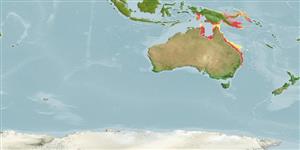Common names from other countries
>
Clupeiformes (Herrings) >
Engraulidae (Anchovies) > Engraulinae
Etymology: Stolephorus: Greek, stole, -es = garment + Greek, pherein = to carry (Ref. 45335).
Issue
Species spelling and Year Paxton et al. 1989 (Ref. 7300:160).
Environment: milieu / climate zone / depth range / distribution range
Ecologia
marino; salmastro; distribuzione batimetrica 10 - 13 m. Tropical; 3°S - 32°S, 134°E - 157°E (Ref. 189)
Western Pacific: Gulf of Carpentaria, southern coast of Papua New Guinea; also Moreton Bay near Brisbane, Queensland, Australia.
Length at first maturity / Size / Peso / Age
Maturity: Lm 5.0 range ? - ? cm
Max length : 5.0 cm SL maschio/sesso non determinato; (Ref. 189)
Spine dorsali (totale) : 0; Spine anali: 0; Raggi anali molli: 19 - 20. Belly with 5 to 7 small needle-like pre-pelvic scutes. Maxilla tip pointed, reaching to or beyond hind border of pre-operculum, the latter concave, indented near maxilla tip. Anal fin origin far forward, below the second to sixth dorsal fin ray bases. The advanced anal fin and the presence of fine teeth on hyoid bones distinguish this species from others in the area.
Presumed coastal, pelagic and schooling. Probably tolerates lowered salinities, judging from the type locality and its occurrence in bays and inlets. Apparently not abundant. More material needed.
Life cycle and mating behavior
Maturities | Riproduzione | Spawnings | Egg(s) | Fecundities | Larve
Whitehead, P.J.P., G.J. Nelson and T. Wongratana, 1988. FAO Species Catalogue. Vol. 7. Clupeoid fishes of the world (Suborder Clupeoidei). An annotated and illustrated catalogue of the herrings, sardines, pilchards, sprats, shads, anchovies and wolf-herrings. FAO Fish. Synop. 125(7/2):305-579. Rome: FAO. (Ref. 189)
IUCN Red List Status (Ref. 130435)
CITES (Ref. 128078)
Not Evaluated
Threat to humans
Harmless
Human uses
Pesca: commerciale
Strumenti
Special reports
Download XML
Fonti Internet
Estimates based on models
Preferred temperature (Ref.
115969): 24.7 - 29.4, mean 27.7 (based on 470 cells).
Phylogenetic diversity index (Ref.
82804): PD
50 = 0.5000 [Uniqueness, from 0.5 = low to 2.0 = high].
Bayesian length-weight: a=0.00537 (0.00253 - 0.01141), b=3.13 (2.96 - 3.30), in cm Total Length, based on LWR estimates for this (Sub)family-body shape (Ref.
93245).
Trophic level (Ref.
69278): 3.2 ±0.4 se; based on size and trophs of closest relatives
Resilienza (Ref.
120179): Alto, tempo minimo di raddoppiamento della popolazione meno di 15 mesi (K>0.3).
Fishing Vulnerability (Ref.
59153): Low vulnerability (10 of 100).
